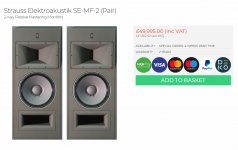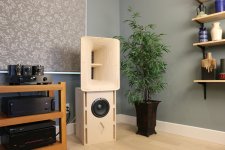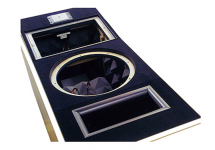The slope and curvature both have limit of zero, they do, but that doesn't mean that the parabolic curve approach a straight line. It does not! It's just not so easy. This is my last try 🙂You guys are addressing the increase in y but do not want to address that the slope and curvature are approaching zero in the limit for a paraboloid.
Last edited:
Anyway, we are leaving the casino now, $13,800 richer than when we came.
That would almost buy you one of the Strauss Monitors that have been mentioned a few times within this thread. 😉
Regards
Charles
Try This!
It is not intuitive, but it is "easy". Look at it this way: as the limit is approached, the rate at which y gets larger in respect to x continues to decline (the rate gets smaller and smaller as x gets larger and larger). At infinity that rate is zero. If you like we could characterize a parabola as an ellipse with its center at infinity. WHGThe slope and curvature both have limit of zero, they do, but that doesn't mean that the parabolic curve approach a straight line. It does not! It's just not so easy. This is my last try 🙂
That would almost buy you one of the Strauss Monitors that have been mentioned a few times within this thread. 😉
Regards
Charles
Almost... 😉
Attachments
If you like we could characterize a parabola as an ellipse with its center at infinity. WHG
No, because it isn't bounded at infinity. Just because it looks like either end is getting steeper, doesn't mean it approaches anything.
I wouldn't say it's actually easy or intuitive, but it's very much hopeless.
The discussion may have been hopeless, but funny in a kind of Samuel Beckett "En attendant Godot" way for those not involved.
I am kind of reluctant to even start, do you have the story of the Tar Baby in your culture?
But you deserve better after the excellent work you have contributed to DIY.*
So I can either offer moral support (you have made a heroic effort) or continue the attempts to correct the misapprehension, if you think that will help.
Maybe in a new thread, probably thrashed to death here.
*And Bill's frequently helpful contributions also deserve to be rewarded, I do believe it is a favour to help someone correct their mistake.
I'm just a layman when in comes to acoustics, analytical or FEA approach.
Your maths seems just fine.
Best wishes
David
Last edited:
Maybe it collapses again beyond infinity, like an ellipse with its center there... Who are we to tell 🙂No, because it isn't bounded at infinity. Just because it looks like either end is getting steeper, doesn't mean it approaches anything.
Well, it could expand forever and still approach a cylinder. But that is not the case of parabola. It's quite hard mathematical concept. For example the sum of infinite series of [1/n] (i.e. 1/1 + 1/2 + 1/3 + ...) grows with every added number and goes to infinity (i.e. there is no sum, it doesn't convegre). Now, the sum of [1/(n^2)] (i.e. 1/1 + 1/4 + 1/9 + ...) does grow as well as you add the numbers, BUT approaches the number (pi^2)/6 and never actually reaches this limit. Interesting, isn't it. It's because the second sum grows much, much slowly (and it's not enough even for infinity).
Hi mabat, i've sat out watching the fun, siding with you, and honestly what I see as relatively easy, intuitive math....
I'm no mathmetician by any means, but have an undergrad math major with a fair amount of quantitative grad work. And some unique business experiences with renown mathematicians, which i won't get into.
I still like to get stoned and contemplate the work of dudes like Euler and Fourier....🙂
Anyway, keep up the good work !
And thanks to Bill too...we all need to keep our mellons sharpened from a good friendly debate from time to time 😀
Yes bass duty is done with a 50 liter onken style enclosure using the Fostex FW208HS 8" Woofer.Is there an 8" below?
The cnc-ed horn is stunning.
Dual Neo8 including hornloading results in >95dB (net) sensitivity?
Did you consider a slightly bigger subwoofer driver?
Dual Neo8 including hornloading results in >95dB (net) sensitivity?
Did you consider a slightly bigger subwoofer driver?
The cnc-ed horn is stunning.
Dual Neo8 including hornloading results in >95dB (net) sensitivity?
Did you consider a slightly bigger subwoofer driver?
Thank you. Yes net sensitivity is 95dB after adding the passive crossover.
I could easily go with a larger woofer however I wanted something for small to medium sized listening rooms. For larger rooms I would go with dual 8" with cabinet tipped horizontally. I would also increase the size of the horn by 50% and use three Neo8's. That would be special. 😉
Little inside scoop
In the coming weeks Jürgen Strauss will present an updated version of the SE-MF-2 (after about 20 years): SE-MF-2.1.
The TAD 1601 and Sony SUP T-11 compression driver are replaced with new units; both have been developed by SE GmbH in cooperation with international manufacturers.
The same enclosure and 2386a horn are used, but the crossover point is lowered from 750 to 400Hz.
In the coming weeks Jürgen Strauss will present an updated version of the SE-MF-2 (after about 20 years): SE-MF-2.1.
The TAD 1601 and Sony SUP T-11 compression driver are replaced with new units; both have been developed by SE GmbH in cooperation with international manufacturers.
The same enclosure and 2386a horn are used, but the crossover point is lowered from 750 to 400Hz.
Attachments
Last edited:
Thanks David. In a new thread, like "WHG on parabola cylindricity"? I'm sure that would be a big hit, I'm only afraid I wouldn't keep up with the math 🙂...So I can either offer moral support (you have made a heroic effort) or continue the attempts to correct the misapprehension, if you think that will help.
Maybe in a new thread, ...
Now it's time to stop interrupting this amazing loudspeaker encyclopedia. Sorry guys.
The same enclosure and 2386a horn are used, but the crossover point is lowered from 750 to 400Hz.
Wow! 400Hz crossover point with 2386a! I thought you´d need for that much bigger horns. Or is the driver more important?
Anyway, it sounds very interesting, I´m curios what the Pros will say.
Besides you can buy the old ones much cheaper now, for something like 40,000€🙄
Full horn loading to 400 Hz: https://en.toutlehautparleur.com/media/catalog/product/datasheet/jbl/2386A.pdf
GM
GM
Almost... 😉
50k pound for a passive wooden box? They must have a work force of top 10 golfers at night time only🙂
They are actually handmade in Switzerland and the company is very small. Even if he sells 10 pairs per year he wouldn't become a billionnaire that way (think dealer marging and employees wages).
Regards
Charles
Regards
Charles
Last edited:
- Home
- Loudspeakers
- Multi-Way
- Is it possible to cover the whole spectrum, high SPL, low distortion with a 2-way?


